Abstract
The renal effects of frusemide treatment in infants with respiratory distress syndrome shortly after birth and during the first three postnatal days were evaluated. Eighty five infants were randomly assigned to two groups. Forty two received three doses of intravenous frusemide (1 mg/kg) starting at age, mean (SD) 7.5 (4.1) hours and given at approximately 24 hour intervals. Forty three control infants were treated similarly but were not given frusemide. The groups were comparable in birthweight, gestational age, and Apgar score and in pulmonary status, blood gases, serum electrolytes, and postnatal age. Infants who received frusemide had significantly higher fractional excretion of sodium and chloride at 12 to 24, 24 to 48, and 48 to 72 hours, and higher calcium excretion at 24 to 48 and 48 to 72 hours after entry into the study than control infants. The study group had a significantly higher urine output and greater weight loss than the control group at 48 to 72 hours after entry into the study. There was no significant difference between groups in serum sodium, potassium, and calcium and in fractional excretion of potassium and the glomerular filtration rate. Infants with an Apgar score of more than 3 had higher urine output and had a better diuretic response to frusemide than those with a lower score. The results suggest that perinatal hypoxia may play an important role in renal function and in diuretic response to frusemide shortly after birth and early in the postnatal life of infants with respiratory distress syndrome.
Full text
PDF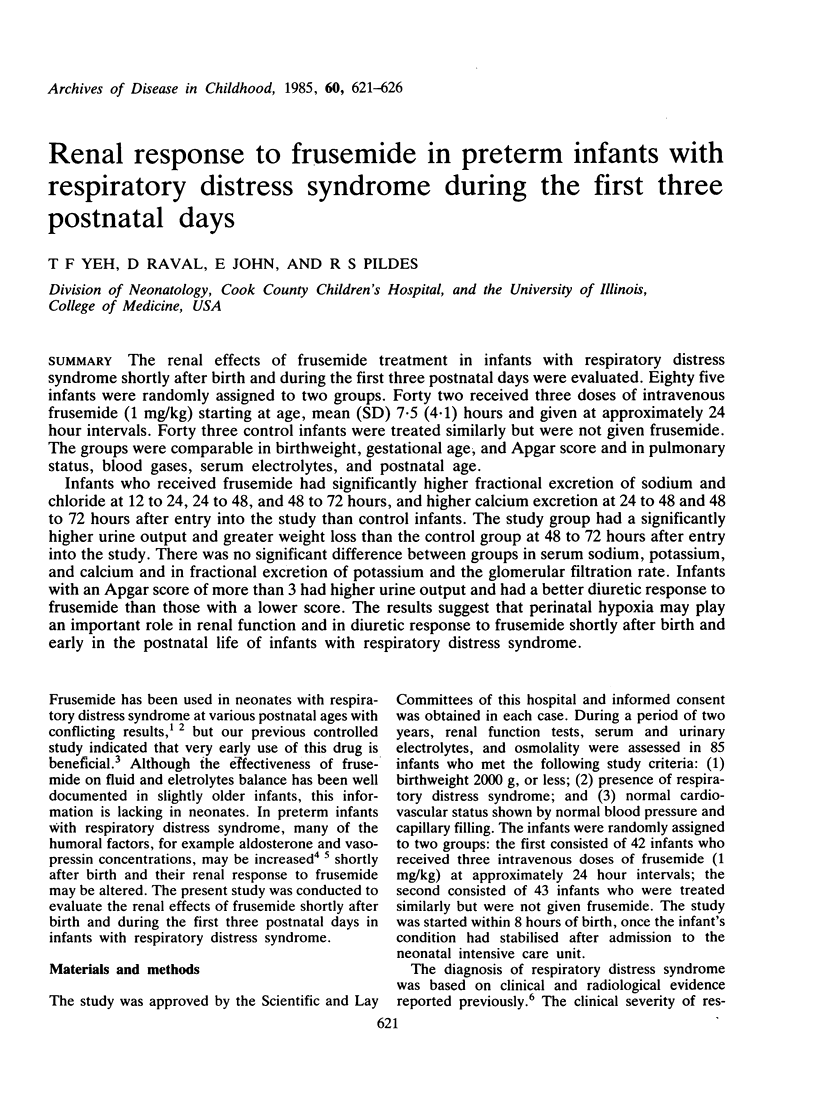

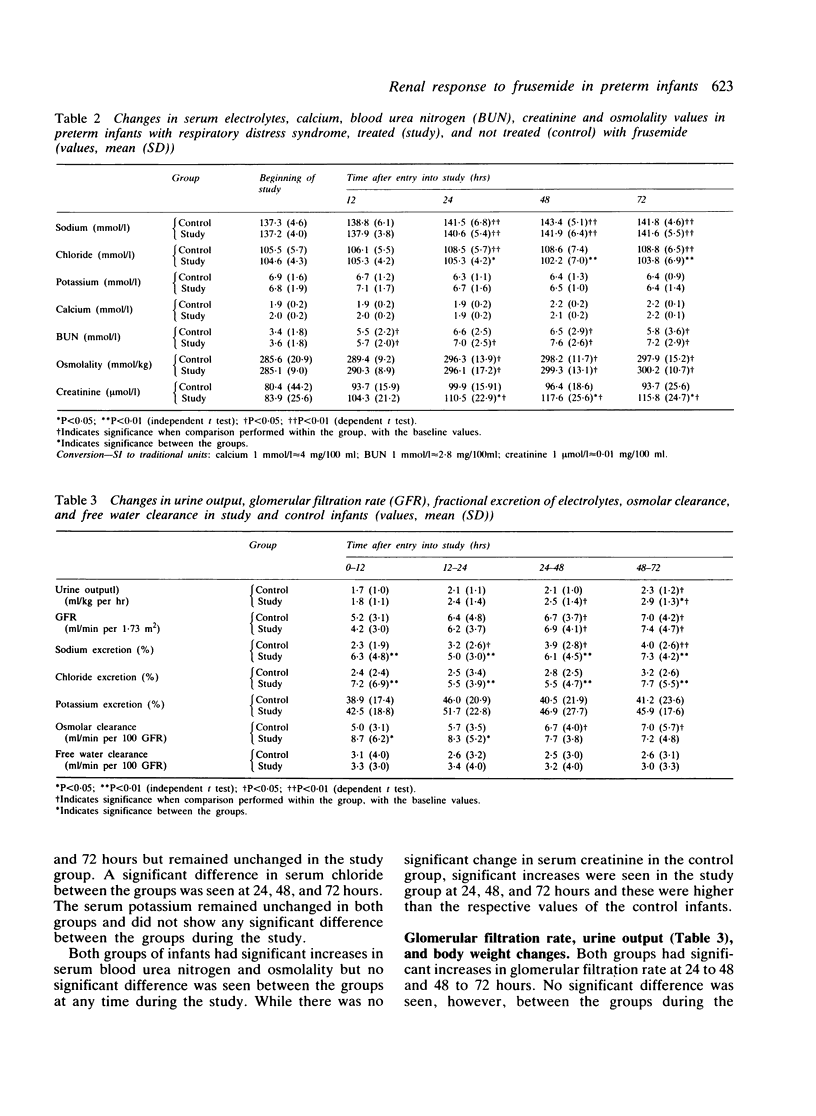
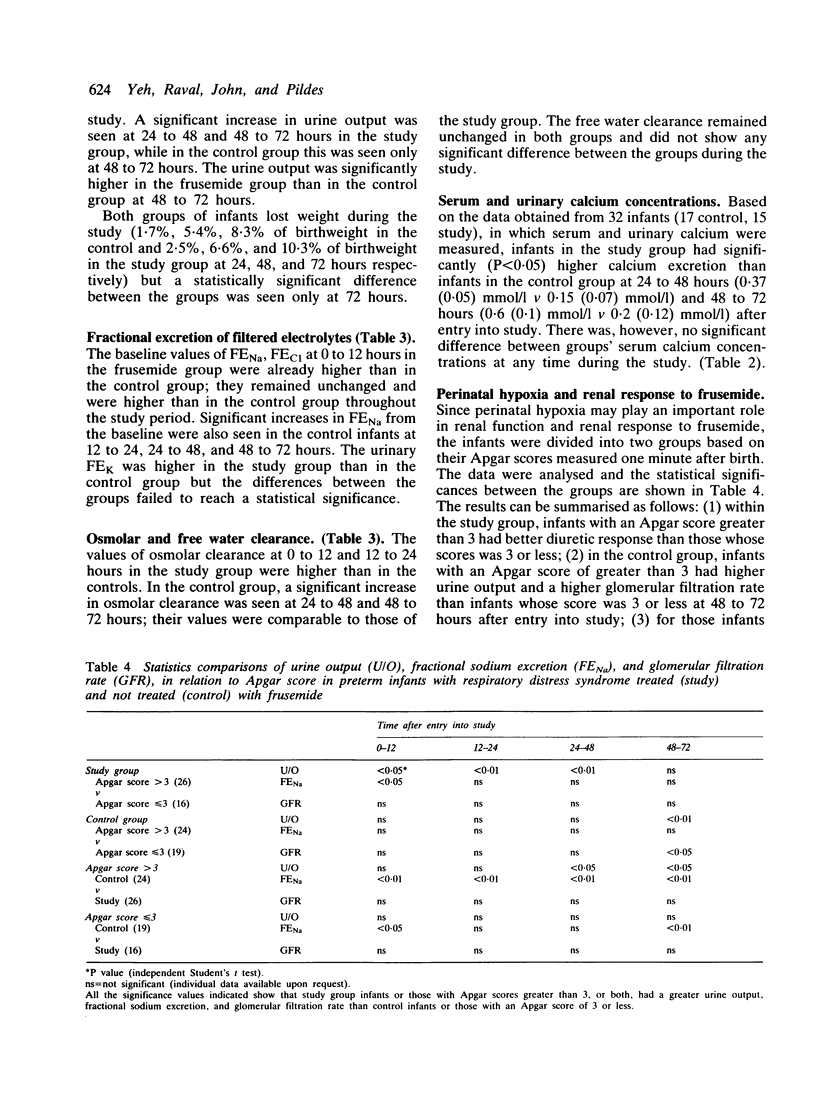
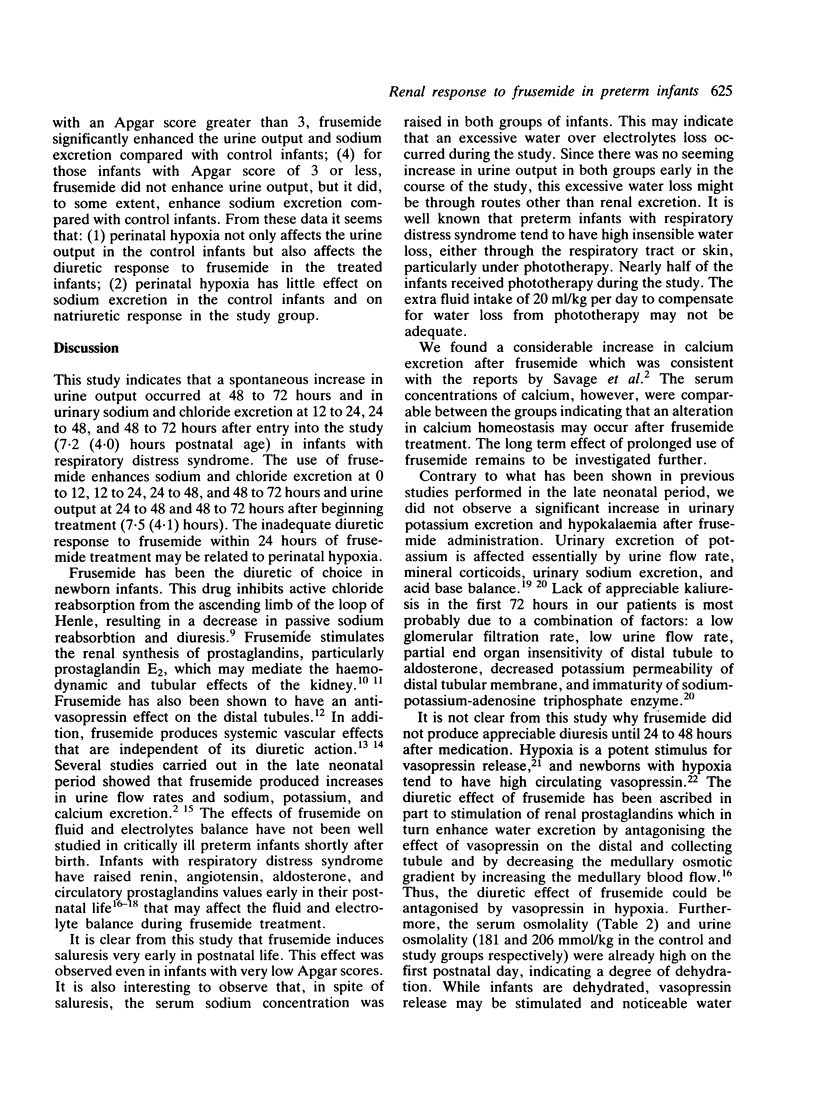
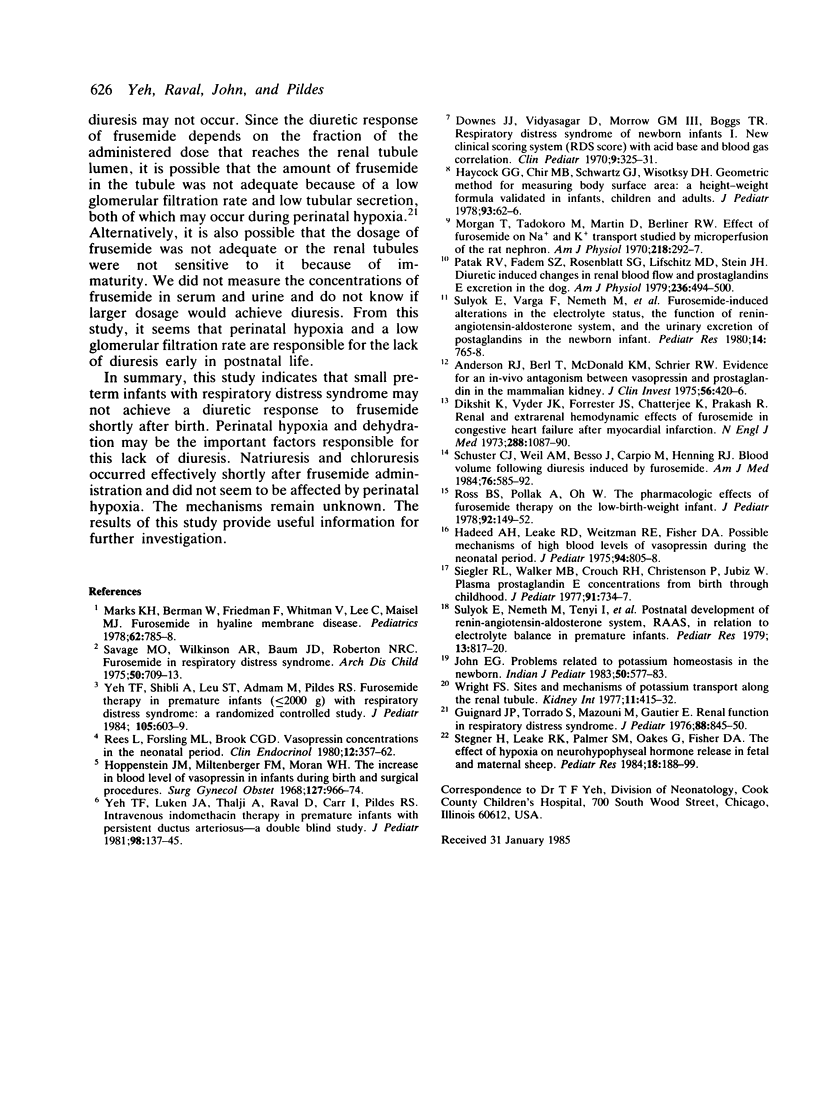
Selected References
These references are in PubMed. This may not be the complete list of references from this article.
- Anderson R. J., Berl T., McDonald K. D., Schrier R. W. Evidence for an in vivo antagonism between vasopressin and prostaglandin in the mammalian kidney. J Clin Invest. 1975 Aug;56(2):420–426. doi: 10.1172/JCI108108. [DOI] [PMC free article] [PubMed] [Google Scholar]
- Dikshit K., Vyden J. K., Forrester J. S., Chatterjee K., Prakash R., Swan H. J. Renal and extrarenal hemodynamic effects of furosemide in congestive heart failure after acute myocardial infarction. N Engl J Med. 1973 May 24;288(21):1087–1090. doi: 10.1056/NEJM197305242882102. [DOI] [PubMed] [Google Scholar]
- Downes J. J., Vidyasagar D., Boggs T. R., Jr, Morrow G. M., 3rd Respiratory distress syndrome of newborn infants. I. New clinical scoring system (RDS score) with acid--base and blood-gas correlations. Clin Pediatr (Phila) 1970 Jun;9(6):325–331. doi: 10.1177/000992287000900607. [DOI] [PubMed] [Google Scholar]
- Guignard J. P., Torrado A., Mazouni S. M., Gautier E. Renal function in respiratory distress syndrome. J Pediatr. 1976 May;88(5):845–850. doi: 10.1016/s0022-3476(76)81129-8. [DOI] [PubMed] [Google Scholar]
- Hadeed A. J., Leake R. D., Weitzman R. E., Fisher D. A. Possible mechanisms of high blood levels of vasopressin during the neonatal period. J Pediatr. 1979 May;94(5):805–808. doi: 10.1016/s0022-3476(79)80162-6. [DOI] [PubMed] [Google Scholar]
- Haycock G. B., Schwartz G. J., Wisotsky D. H. Geometric method for measuring body surface area: a height-weight formula validated in infants, children, and adults. J Pediatr. 1978 Jul;93(1):62–66. doi: 10.1016/s0022-3476(78)80601-5. [DOI] [PubMed] [Google Scholar]
- Hoppenstein J. M., Miltenberger F. W., Moran W. H., Jr The increase in blood levels of vasopressin in infants during birth and surgical procedures. Surg Gynecol Obstet. 1968 Nov;127(5):966–974. [PubMed] [Google Scholar]
- John E. G. Problems related to potassium homeostasis in the newborn. Indian J Pediatr. 1983 Nov-Dec;50(407):577–583. doi: 10.1007/BF02957722. [DOI] [PubMed] [Google Scholar]
- Marks K. H., Berman W., Jr, Friedman Z., Whitman V., Lee C., Maisels M. J. Furosemide in hyaline membrane disease. Pediatrics. 1978 Nov;62(5):785–788. [PubMed] [Google Scholar]
- Morgan T., Tadokoro M., Martin D., Berliner R. W. Effect of furosemide on Na+ and K+ transport studied by microperfusion of the rat nephron. Am J Physiol. 1970 Jan;218(1):292–297. doi: 10.1152/ajplegacy.1970.218.1.292. [DOI] [PubMed] [Google Scholar]
- Rees L., Forsling M. L., Brook C. G. Vasopressin concentrations in the neonatal period. Clin Endocrinol (Oxf) 1980 Apr;12(4):357–362. doi: 10.1111/j.1365-2265.1980.tb02720.x. [DOI] [PubMed] [Google Scholar]
- Ross B. S., Pollak A., Oh W. The pharmacologic effects of furosemide therapy in the low-birth-weight infant. J Pediatr. 1978 Jan;92(1):149–152. doi: 10.1016/s0022-3476(78)80098-5. [DOI] [PubMed] [Google Scholar]
- Savage M. O., Wilkinson A. R., Baum J. D., Roberton N. R. Frusemide in respiratory distress syndrome. Arch Dis Child. 1975 Sep;50(9):709–713. doi: 10.1136/adc.50.9.709. [DOI] [PMC free article] [PubMed] [Google Scholar]
- Schuster C. J., Weil M. H., Besso J., Carpio M., Henning R. J. Blood volume following diuresis induced by furosemide. Am J Med. 1984 Apr;76(4):585–592. doi: 10.1016/0002-9343(84)90281-x. [DOI] [PubMed] [Google Scholar]
- Siegler R. L., Walker M. B., Crouch R. H., Christenson P., Jubiz W. Plasma prostaglandin E concentrations from birth through childhood. J Pediatr. 1977 Nov;91(5):734–737. doi: 10.1016/s0022-3476(77)81025-1. [DOI] [PubMed] [Google Scholar]
- Stegner H., Leake R. D., Palmer S. M., Oakes G., Fisher D. A. The effect of hypoxia on neurohypophyseal hormone release in fetal and maternal sheep. Pediatr Res. 1984 Feb;18(2):188–191. doi: 10.1203/00006450-198402000-00016. [DOI] [PubMed] [Google Scholar]
- Sulyok E., Németh M., Tényi I., Csaba I., Györy E., Ertl T., Varga F. Postnatal development of renin-angiotensin-aldosterone system, RAAS, in relation to electrolyte balance in premature infants. Pediatr Res. 1979 Jul;13(7):817–820. doi: 10.1203/00006450-197907000-00005. [DOI] [PubMed] [Google Scholar]
- Sulyok E., Varga F., Németh M., Tényi I., Csaba I. F., Ertl T., Györy E. Furosemide-induced alterations in the electrolyte status, the function of renin-angiotensin-aldosterone system, and the urinary excretion of prostaglandins in newborn infants. Pediatr Res. 1980 May;14(5):765–768. doi: 10.1203/00006450-198005000-00011. [DOI] [PubMed] [Google Scholar]
- Wright F. S. Sites and mechanisms of potassium transport along the renal tubule. Kidney Int. 1977 Jun;11(6):415–432. doi: 10.1038/ki.1977.60. [DOI] [PubMed] [Google Scholar]
- Yeh T. F., Luken J. A., Thalji A., Raval D., Carr I., Pildes R. S. Intravenous indomethacin therapy in premature infants with persistent ductus arteriosus--a double-blind controlled study. J Pediatr. 1981 Jan;98(1):137–145. doi: 10.1016/s0022-3476(81)80560-4. [DOI] [PubMed] [Google Scholar]
- Yeh T. F., Shibli A., Leu S. T., Raval D., Pildes R. S. Early furosemide therapy in premature infants (less than or equal to 2000 gm) with respiratory distress syndrome: a randomized controlled trial. J Pediatr. 1984 Oct;105(4):603–609. doi: 10.1016/s0022-3476(84)80431-x. [DOI] [PubMed] [Google Scholar]


